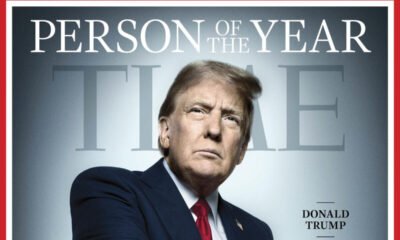Markets
FII Selling Records Colossal Rs 50,000 Crore This Month. How Bad Can It Get? A Lot, Curtsey Trump Administration
Published
9 months agoon

The start of 2025 has been nothing short of a nightmare for Indian equity markets. With foreign institutional investors, FII selling off a colossal ₹50,000 crore in just 15 trading days, the Sensex has plunged 2,300 points while the Nifty has shed 2.6%.
The shockwaves from this outflow are reverberating across Dalal Street, with market watchers asking – How much worse can it get?
Unfortunately, the answer could be a lot, and part of the blame might lie with the Trump administration.
The Trump Effect. Pro-America Policies Could Siphon Liquidity
Donald Trump’s reentry into the White House has reignited fears of an FII exodus from emerging markets like India. His pro-America stance, coupled by potential tariff hikes and hardline immigration policies, is expected to draw global liquidity back to Wall Street. If Trump’s fiscal and trade policies end up being inflationary, the Federal Reserve may have to slow down its rate-cut cycle, driving bond yields higher and making US markets more attractive.
The fallout is already evident. The Indian rupee has depreciated by 3% this month, touching a record low of ₹86.70 against the US dollar. This currency weakness, coupled with lackluster Q3 earnings from Indian corporates, has given FIIs little reason to stay invested.
Earnings Season Disappoints. Mixed Signals from Indian Heavyweights
The ongoing Q3 earnings season has failed to inspire confidence. While stalwarts like TCS and Reliance Industries delivered positive surprises, the broader narrative is bleak. InCred Equities reports flat profit growth year-on-year on just 4% sales growth. Consumer-facing companies like Zomato have reported signs of a slowdown, painting a worrying picture of waning demand.
A BofA Securities survey of fund managers across Asia reveals a growing consensus that India is falling off the radar for global investors. With tepid corporate results and a challenging macroeconomic environment, the sentiment is far from optimistic.
What Lies Ahead – Bond Yields, Dollar Strength, and Market Stabilization
The surge in US bond yields and the strengthening dollar are compounding India’s woes. Commodity Futures Trading Commission data shows funds building their largest long positions on the dollar since 2016, betting on a robust US economy buoyed by Trump’s policies and “higher for longer” interest rates.
For Indian markets to find stability, several factors need to align –
- Bond Yield Stabilization: Rising yields in the US make emerging markets less attractive. A pause in this trend is crucial.
- Dollar Moderation: A strong dollar erodes returns for FIIs in local currencies, accelerating outflows.
- Global Risk Appetite: Geopolitical and economic uncertainties must ease for investors to regain confidence.
The relentless selling by foreign institutional investors (FIIs) shows no signs of abating, as a resilient dollar and attractive US bond yields continue to pull global capital toward Wall Street. EPFR data highlights consistent outflows from India-dedicated ETFs since October 2024, a period coinciding with markets pricing in Donald Trump’s return to the presidency.
The trend is worrying, but market experts suggest that the tide could turn under two scenarios – a decline in the dollar and US bond yields or positive news about India’s economic growth and corporate earnings. The latter, while possible, is unlikely to materialize until early 2025.

A Resilient Dollar and Its Ripple Effects
Trump’s commitment to the “mighty dollar” has pushed the greenback higher, pressuring emerging market currencies, including the Indian rupee. The rupee, currently trading near ₹86.70, may see further depreciation, with analysts predicting a floor around ₹88-89. Competitive devaluation of the Chinese yuan, a probable response to Trump’s tariffs, could heighten the pressure on the rupee and other emerging market currencies.
However, the dollar’s current rally may not last indefinitely. Analysts believe that after the initial appreciation fueled by Trump’s policies, the dollar is likely to stabilize, offering some medium-term relief to emerging markets.
Emerging Markets Under Pressure
The outlook for emerging markets remains challenging in 2025, with sustained outflows expected. As leverage trades unwind and global risk appetite remains muted, equity valuations in India and other emerging markets could face continued downward pressure.
A Contrarian View. Why FII Flows Could Rebound
While the consensus view links a stronger US economy to FII outflows from India, Elara Securities offers a contrarian perspective. Citing the Citi US Economic Surprise Index (CESI), the firm notes a 25% positive correlation between stronger US economic data and FII inflows into India.
Historical analysis supports this argument. Empirical models suggest that a 1% positive surprise in US economic data leads to an average inflow of $82 million into Indian equities within a month. Additionally, past cycles indicate that FII flows typically bottom 58 days after a trough in US economic data surprises.
Is a Bottoming Out in Sight?
Elara Securities suggests that the CESI cycle has bottomed, with recent US economic data surprising on the upside. If this trend continues, FII flows into India could bottom out by January-February 2025. Once the rupee stabilizes around ₹88-89, equity markets are likely to regain some footing, with passive FII flows making a comeback.
Market Selloff. Should Investors Stay Put or Recalibrate?
As the market grapples with increased volatility and FIIs pull out record sums, the “buy the dip” mantra, a favorite during bull runs, may not be the safest bet this time. With many high-valuation stocks undergoing a phase of mean reversion, investors need to tread carefully and adopt a more strategic approach.

Avoid the Valuation Trap
The biggest risk for investors isn’t market volatility—it’s holding onto assets that can’t justify their valuations.
“Investors should actively trim weak holdings, especially those unlikely to meet growth expectations, and redeploy capital into resilient, high-conviction names,” says Rishabh Nahar, Partner and Fund Manager at Qode Advisors.
Stocks with inflated valuations, particularly in sectors that are vulnerable to external shocks, may face prolonged corrections. This calls for a reassessment of portfolios with an eye on fundamentals, growth potential, and valuation metrics.
Diversify to Weather the Storm
In times of uncertainty, diversification remains key. Allocating capital to gold and high-quality debt instruments can provide stability while preserving liquidity for future redeployment. Gold, often a safe haven in turbulent times, offers a hedge against currency depreciation and inflation, while high-quality debt ensures steady returns with lower risk.
Opportunities Amid the Chaos
Despite the broader selloff, certain sectors appear well-positioned to weather the Trump administration’s policies. Sectors like banking, NBFCs, auto, and real estate are relatively immune to external shocks and offer opportunities for long-term investors.
Real Estate, A Trump-Driven Opportunity?
Trump’s immigration stance could have an unintended silver lining for Indian real estate. If even 10% of Indian professionals working in the US decide to relocate to India, the demand for premium housing could see a significant uptick. Real estate developers, particularly those catering to the high-income segment, stand to benefit.
Auto and Banking Resilience
With domestic demand largely insulated from global policy shifts, the auto sector and financial institutions could see steady growth. Robust consumption patterns and ongoing urbanization trends offer a buffer against external shocks.
Global Cues
Interestingly, German and UK markets have hit 52-week highs despite Trump’s known concerns about the US trade deficit with Germany. While India’s trade surplus with the US is relatively modest compared to other nations, it may not face the same level of scrutiny.
However, investors should remain cautious about sectors heavily reliant on exports to the US, as any protectionist policies could dampen growth prospects.
What Should Investors Do Now?
Trim the Fat: Identify and exit holdings with unsustainable valuations or weak fundamentals.
Focus on Quality: Reallocate capital to high-conviction names with proven resilience and growth potential.
Diversify: Build exposure to gold and high-quality debt to mitigate volatility.
Sectoral Bets: Look for opportunities in sectors like real estate, banking, NBFCs, and auto, which are less likely to be impacted by Trump’s policies.
Stay Liquid: Maintain liquidity to take advantage of attractive entry points during market corrections.
)
Long-Term Perspective
While the current selloff may feel unsettling, history shows that markets have a way of stabilizing and rewarding patient investors. By staying disciplined, focusing on quality, and keeping a long-term perspective, investors can weather the storm and position themselves for the eventual recovery.
While Trump’s policies might aim to revitalize the American economy, their ripple effects are being felt worldwide, especially in emerging markets like India. Analysts warn that further FII outflows could be on the horizon as leveraged trades unwind and equity valuations face pressure.
For now, Indian markets are in for a bumpy ride. The focus should be on macroeconomic stability and policies that attract long-term investors to counterbalance the FII Selling. Until then, brace for continued volatility
You may like
-


Warren Buffett’s Massive Cash Hoard Sparks Market Jitters—But Here’s Why You Shouldn’t Panic
-


Why Are Japanese Companies Not Happy With Trump? How Trump 2.0 Is Shaking The World Into A ‘Rude’ Awakening?
-


Brutal Selloff In India’s Stock Market. What’s The Ideal Position – Buy Or Sell? Will IPO Euphoria Fizzle Out In 2025?
-


Cooling Period For Mexico And Canada As Trump Pauses Tariffs– Global Stocks Rebound, China Still In Limbo But Will It Bow Down To Trump And What’s India’s Tariff Deal So Far?
-


It’s Simple—Indian Govt Isn’t Tightening Spending—It Just Isn’t Spending Enough. How This Has Costed India’s Growth Story
-


Budget 2025. What’s FM’s Game Plan? Boost Growth, Cut Deficit, Or Finally Listen To The Struggling Middle Class?
